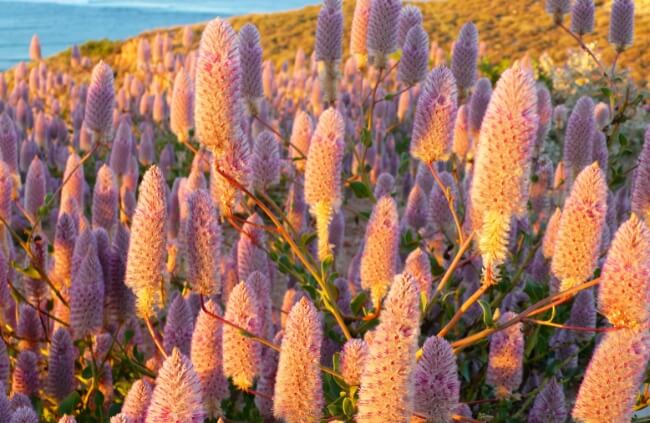Ptilotus exaltatus is an Australian native with lots of ornamental appeal due to its stunning and distinctive pinkish mauve flowers. Suitable for growing in most parts of Australia, the Pink Mulla Mulla is an easy to look after, hassle-free, attractive plant.
If you would like to add Ptilotus exaltatus to your garden, here is everything you need to know to sow, grow and care for them at home.
More...
Botanical name: | Ptilotus exaltatus |
|---|---|
Botanical family: | Amaranthaceae |
What is Ptilotus exaltatus?

Ptilotus exaltatus is more commonly known as Mulla Mulla or Pink Mulla Mulla. They are famous for their beautiful conical spikes of feathery flowers, which look spectacular as cuttings in flower arrangements.
A native Australian plant that grows well in warm temperate, semi-arid and arid climates. They are a perennial herb, with a short life cycle so are often grown as annuals.
It is a small shrub, growing to less than a metre high, with thick blue-green leaves. The Ptilotus exaltatus flowers are typically pink or purple in colour. The striking flower spikes are about 10 cm in size, with dense pointed petals.
They are heat and drought tolerant plants that can also withstand light frost when established.
How to Grow Pink Mulla Mulla
When to Plant Ptilotus exaltatus?
If you plan on growing mulla mulla from seed the best time to sow the seeds is in November. They then grow rapidly and flower from mid-autumn. Ptilotus exaltatus can be grown all year round but sowing seeds in warmer months is less ideal.
Where to Position Mulla Mulla?
Ptilotus exaltatus should be positioned in a warm, sunny part of the garden. A sunny location is an essential ingredient of success when growing Ptilotus exaltatus. They should be getting at least around 8 hours of sunlight a day.
Mulla mulla is best potted or planted in hot, dry areas of the garden, with excellent water drainage. Rockeries or container pots getting full sun are ideal and they can look spectacular as a complement to other natives or annuals.
Given the drought resistant nature of these Australian natives, they are ideal plants for putting in pots on a north facing patio or balcony, where other plants might suffer. Position in the middle or back of a garden display or pot, as the upright flower will contrast beautifully with those plants at the front.

Best Soil for Pink Mulla Mulla
Ptilotus exaltatus need well-drained soil to thrive. A light, loose sandy soil is ideal, but it will do okay in most soil types as long as they are well-drained. Mix with lots of compost before planting.
If using a potting mix, look for a quick draining medium, ideally without a long list of additives or wetting agents.
How to Care for Ptilotus exaltatus
Pink mulla mulla is a quick-growing, short-lived plant that is low maintenance. The Australian native doesn’t need any additional fertiliser if it was planted in good quality soil, to begin with.
They are drought-tolerant plants and rarely require watering. A common mistake is to overwater them, as they will often die in standing water. If planted in pots, make sure to let the soil dry out completely between watering.
Mulla Mulla Frequently Asked Questions
When does the Mulla Mulla flower?
In Australia, Ptilotus exaltatus flower from April to November. The long-lasting, attractive flower spikes have soft feathery pink-purple petals and make for a wonderful cut flower.
How long does it take to grow Ptilotus exaltatus?
The mulla mulla plant is quick to grow. It normally takes about only around 14-16 weeks from sowing to flowering. You will then get to enjoy months of brilliant pink-purple colour.
Wrapping Up Our Ptilotus exaltatus Guide
Pink mulla mulla are easy to grow in most parts of Australia. They will thrive in good, well-draining soil, if they get plenty of sunlight and you don’t overwater them.
Ptilotus exaltatus needs little maintenance and will provide you with an extended display of beautiful pink-purple flowers. Enjoy growing Ptilotus exaltatus in your home.
Published on August 24, 2023 by Gary Clarke
Last Updated on January 21, 2024





When Mulla Mulla is growing wild, the seeds are blown away to land where they will.
They grow with very little rainfall If I simulate this in my frontage will they grow
Thanks
Hi Lorraine,
It depends on where you live and what the ground is like there. In theory, yes, broadcast sowing mulla mulla will work, but you’ll have to do it at the right time of year, and prepare the ground I advance. They don’t germinate well with competition, so clear the area you’re planting first if possible.
They need free-draining, sandy, soil if you’ve got it. If you’ve got moisture retentive loamy soil in the garden, either dig a load of sand through, or use the same method in pots. Or, just grow them on first in containers and plant into the ground by improvising just that section of soil first.
Good luck with it and let us know how you get on!
Gary Clarke
Aussie Green Thumb